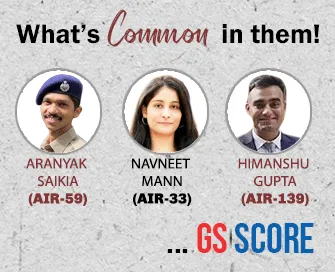

13th September 2023 (9 Topics)
Editorials
Context:
India's foreign policy faces challenges from South Asian democracies, but now it is important that India focus on strategy to deal with the Maldives, as its presence matters in the Indian Ocean region (IOR).
Maldives President's Electoral Challenge
- Solih's Electoral Challenge: Solih's "India First" policy faces a challenge as he secures 05% in Maldives' election, with a runoff against Muizzu.
- Nasheed's Political Shift: Nasheed's support shift to Muizzu alters political dynamics.
- Impact on India's Regional Strategy: Election outcome impacts India's regional strategy, countering China's influence in the Indian Ocean.
Religious Extremism and Foreign Influence
- Religious Extremism and ISIS Affiliation: Maldives has witnessed a surge in religious extremism, with a notable number of citizens reportedly joining ISIS. This trend raises security concerns.
- Muizzu's Salafist Backing: Adding support to prominent Salafist NGO adds complexity to the political landscape, potentially influencing the nation's religious dynamics.
- India-China Rivalry in the Maldives: Amidst India-China competition for influence in the Maldives, the political drama involving shift in support and Solih's electoral challenge could impact India's "Neighbourhood First" policy aimed at countering China's growing presence in South Asia.
Strategic Significance and India's Stance
- Strategic Location as a "Toll Gate": The Maldives, situated in the Indian Ocean, serves as a crucial point for international sea routes. It holds significance due to its location between key sea lanes.
- China’s Influence: Despite President Solih's attempts to balance relations with India, Beijing has maintained its influence in the Maldives, reflecting the complexities of regional diplomacy.
- India's Proactive Diplomacy: India has pursued proactive diplomacy in the region through defense pacts and infrastructure development. These efforts aim to safeguard India's strategic interests and counter China's growing presence.


Editorials
Context:
As per the recent ruling by a Constitution Bench of the Supreme Court regarding the retrospective application of Section 6A of the Delhi Special Police Establishment Act, has raised questions about the balance between accountability and protection in anti-corruption laws and its implications for past and future corruption cases.
Retrospective Effect of 2014 Verdict
- Supreme Court Retroactive Ruling: Supreme Court's 2014 verdict on Section 6A made retrospective to 2003. Section 6A needed central approval for corruption probes against senior officials.
- Constitution vs. Laws: Upholds the principle that post-Constitution laws can't contradict the Constitution, it must ensure alignment with legal and constitutional principles.
- Impact on Corruption Cases: Affects past cases between 2003 and 2014 under Section 6A. Highlights the challenge of balancing accountability and effective anti-corruption measures.
Limited Applicability
- Temporal Limitations of Ruling: Ruling applies solely to allegations between 2003 and 2014 under Section 6A. Excludes cases post-2014 with Section 17A's government approval mandate.
- 2018 Amendments and Section 17A: 2018 amendments introduced Section 17A, necessitating government approval for investigations into public servants' decisions. Balancing safeguards with justice and transparency remains crucial.
- Anti-Corruption Provisions: Striking a balance is essential between anti-corruption safeguards and ensuring efficient, transparent investigations. Ensuring fairness while preventing misuse is a complex challenge.
Balancing Accountability and Protection
- For fair investigations: Balancing accountability and protection ensures effective, fair investigations.
- Challenges of Fairness: The challenge is to maintain fairness without impeding genuine corruption probes.
- Purpose of Anti-Corruption Laws: Laws should serve their intended purpose, exposing corruption and shielding unscrupulous individuals.


Editorials
Context:
As it has been six years since the Puttaswamy case got its pace, India is continually focusing on privacy Jurisprudence.
Expanding the Right to Privacy
- Background and the Puttaswamy Judgment: It expanded the understanding of privacy, emphasizing autonomy, dignity, and identity as key principles.
- Impact on Legal Landscape: The Supreme Court (SC) has used the right to privacy to decriminalize same-sex relations and adultery, promote interfaith and inter-caste marriages, and uphold the right to die with dignity.
- Challenges: The SC's evolving privacy jurisprudence is shaping fundamental rights and freedoms in India.
Future of Privacy Jurisprudence in India
- Implications and Ongoing Challenges: The SC will decide on the Pegasus spyware allegations, LGBTQIA+ marriage rights, and Digital Personal Data Protection Act
- Pivotal Cases Ahead: These cases will shape the evolution of fundamental rights and freedoms.
- Continued Expansion: The Court's role is to enable individuals to effectively exercise their rights and freedoms in India.
Way forward
- Balancing Rights and Restrictions: While privacy rights have expanded, some restrictions have been imposed, such as on wearing hijabs in educational institutions.
- Focus on individual Rights: The challenge is to strike a balance between individual rights and societal interests.
- Right to Privacy as a Fundamental Right and must get a fair Constitutional recognition.


Editorials
Context:
AI presents well-documented challenges in biased models, privacy issues, and opaque decision-making, impacting diverse sectors and solutions demand creativity and responsibility.
AI's Rapid Growth
- Increasing Role of AI: AI is rapidly advancing, with significant private investment and company adoption.
- Concerns: It also risks undermining public discourse integrity and raising concerns in defense frameworks.
- The Fear of Artificial General Intelligence: The possibility of AI systems gaining too much autonomy is a significant concern.
International Cooperation and Standards
- Worldwide Consensus on AI Risks: Establishing global consensus on AI risks is crucial to prevent vulnerabilities.
- Setting Standards for AI Services: International standards promote inter-operability and cooperation across regions.
- Promoting Equitable AI Development: Innovative public-private partnership models and regulatory sandbox zones can drive AI progress while addressing social challenges.
Embracing AI with Caution
- Emphasize responsibility: AI's potential is undeniable, but it must be approached with caution and foresight.
- Development and deployment: Ensuring control over AI's development and deployment is crucial for its responsible use.
- Frame rules with global consensus: Efforts have been made globally to address these challenges, including regulatory frameworks and standards.




